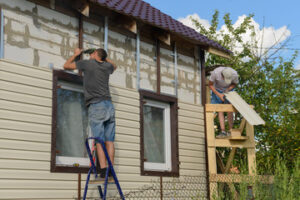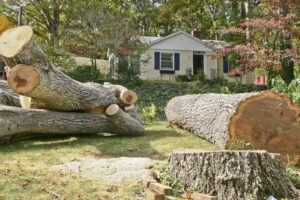Siding can enhance your home’s curb appeal and increase its value. It can also save on energy costs and help reduce your maintenance and repair expenses.
There are many types of siding available, and the material you choose can have a big impact on its durability and lifespan. For example, real wood requires more maintenance, such as painting or staining, than fiber cement. Visit Our Website to learn more.

Choosing The Right Siding
Your home’s exterior is the first thing that visitors see, and it can either enhance your property or detract from its curb appeal. This is why it is essential to choose the right siding for your home—not only to improve its appearance but also to ensure that it withstands the weather and other environmental factors.
With so many options available, it can be difficult to know which one is best for your house. Different types of siding have a variety of pros and cons, including durability, lifespan, maintenance requirements, and cost. Ultimately, the choice will come down to personal preferences and budget.
The most popular type of siding is vinyl, which offers affordability and versatility. However, it is susceptible to warping and cracking over time. It can also lack the aesthetic of more natural materials, such as wood or fiber cement.
Wood siding is a classic choice that can add a touch of elegance to your home’s exterior. Its benefits include a timeless look, durability, and resistance to rot and insects. However, it can be costly compared to other options and requires frequent maintenance to maintain its appearance.
Metal siding is another option that has become more popular recently, thanks to its strength, durability, and low maintenance requirements. It is available in a range of colors and is easy to install. However, it can be prone to rusting and requires periodic painting or staining.
Fiber cement and engineered wood are other popular choices because of their durability, versatility, and relatively low costs. They are less prone to fading than vinyl and have an attractive, natural appearance that is often stained or painted. They also require less maintenance compared to real wood, which must be treated and inspected regularly.
Manufactured stone siding has the sought-after beauty and texture of natural rock but comes at a lower price tag and requires less maintenance. It’s also fire-resistant and durable, resisting moisture, and rots better than most other types of siding.
When choosing the color of your siding, consider the overall style of your home and any homeowners’ association guidelines. You may want to stick with a neutral shade or use contrasting colors for architectural features like window trim, gables, and doors.
Preparation
During the process of installing new siding, you must prepare your home. You’ll need to make sure that you’ve trimmed any bushes or shrubs and cleared your yard of any furniture or outdoor decorations. This will give the crew access to your home’s exterior walls and ensure that they can work quickly and efficiently. It’s also important to cover any flower beds or lawns with tarps or drop cloths. This will minimize the risk of stains from debris and paint, as well as protect your plants.
In addition to preparing the yard, you should also move any items that are stored on or leaning against your home’s walls. This will prevent damage caused by vibration or shifting during the installation process. It’s also a good idea to relocate any delicate items, such as collectibles or porcelain decorations.
If you’re planning to hire a contractor for your siding installation project, be sure to take the time to interview several candidates and choose one that has a solid reputation. In addition to price, pay special attention to how the contractors communicate with you and their level of professionalism. You’ll also want to choose a contractor that offers warranties that guarantee a certain level of work, as this will provide you with peace of mind that your investment is safe.
It’s also a good idea to ask your contractor if they can perform a pre-installation inspection. This will allow you to catch any potential problems, such as dry rot or mold. This can save you a lot of time and money in the long run, as well as help to protect your investment.
It’s also a good idea to hire a local contractor. This will minimize the chance of a dishonest or fraudulent contractor taking advantage of you and your family during an emergency. After all, scam artists are known to swoop in after natural disasters and do shoddy work to cash in on the emergency relief funding provided by insurance companies. A reputable local contractor will be more likely to have the necessary experience and resources to handle any type of situation.
Installation
Investing in new siding is an effective way to improve your home’s curb appeal. It safeguards your house against harsh weather conditions and moisture, promoting longevity and durability. The right siding is also a great investment in your property’s value, as it can enhance your home’s appearance and contribute to its energy efficiency.
It is important to work with an experienced contractor that offers a warranty for their services. It is also important to have a clear understanding of the installation process before starting the project. This will ensure that you have realistic expectations and can avoid any unexpected issues.
The first step in the installation process is putting down a starter strip along the bottom of the wall. Then, sheath the first few feet of the wall and start nailing in the siding. It’s important to keep in mind that the siding will expand and contract as it is installed, so it’s essential to leave room for this expansion and contraction without causing damage or leaving gaps.
When installing the siding, it is best to use galvanized nails that are spaced a few inches apart and pre-painted to prevent rusting. It’s also a good idea to use a level during the process to ensure that each piece is aligned and securely nailed.
Once the siding is installed, it’s a good idea to finish the project by caulking any potential points of water penetration. This will protect your house from rain and snow, which will minimize maintenance costs in the future. Finally, it’s a good idea to trim any shrubbery or trees that are close to the house. This will help prevent them from falling during the installation process and will make it easier for the contractors to reach the walls without removing anything else.
While the process of installing new siding may seem daunting, it’s important to work with a professional contractor who has experience and can provide a warranty for their services. This will ensure that your siding is installed correctly and lasts for years to come. In addition, new siding is a great way to add value to your home and can increase its marketability.
Maintenance
There are many reasons to replace your siding, from boosting curb appeal to reducing energy bills. New siding also protects your home from the elements and adds value to your property. However, it is important to choose and install the right materials to ensure longevity and maximize your return on investment.
Siding is often a high-cost improvement, so it’s vital to work with an experienced and trustworthy contractor. This way, you can rest assured knowing your project will be done correctly and you’ll get the results you expect.
Choosing the right siding is important because it determines how your home looks and functions. You want to make sure you choose a color that you’ll enjoy for years to come and that will hold up against changing trends in your neighborhood or the greater housing market.
A high-quality, properly installed siding can significantly reduce drafts and hot/cold spots in your home, improving comfort for you and your family. It also helps regulate indoor temperatures, which can save you money on heating and cooling costs.
It’s important to inspect your siding for damage or wear and tear regularly. Some signs that you need to call a professional for repairs or replacement include:
When it comes to maintenance, washing your home’s siding should be done at least twice per year. A garden hose, sponge, and mild detergent should remove dirt from the surface. A solution of equal parts water and vinegar can be used to tackle mold or mildew stains. Be sure to test any cleaning solutions on a small, inconspicuous area first.
It’s also a good idea to inspect your home after major storms. Look for signs of weather damage, such as cracks, dents, loose panels, and damaged gutters. In addition to repairing any issues, you should also walk around your house to make sure there are no areas that need additional reinforcement or protection from the elements.







